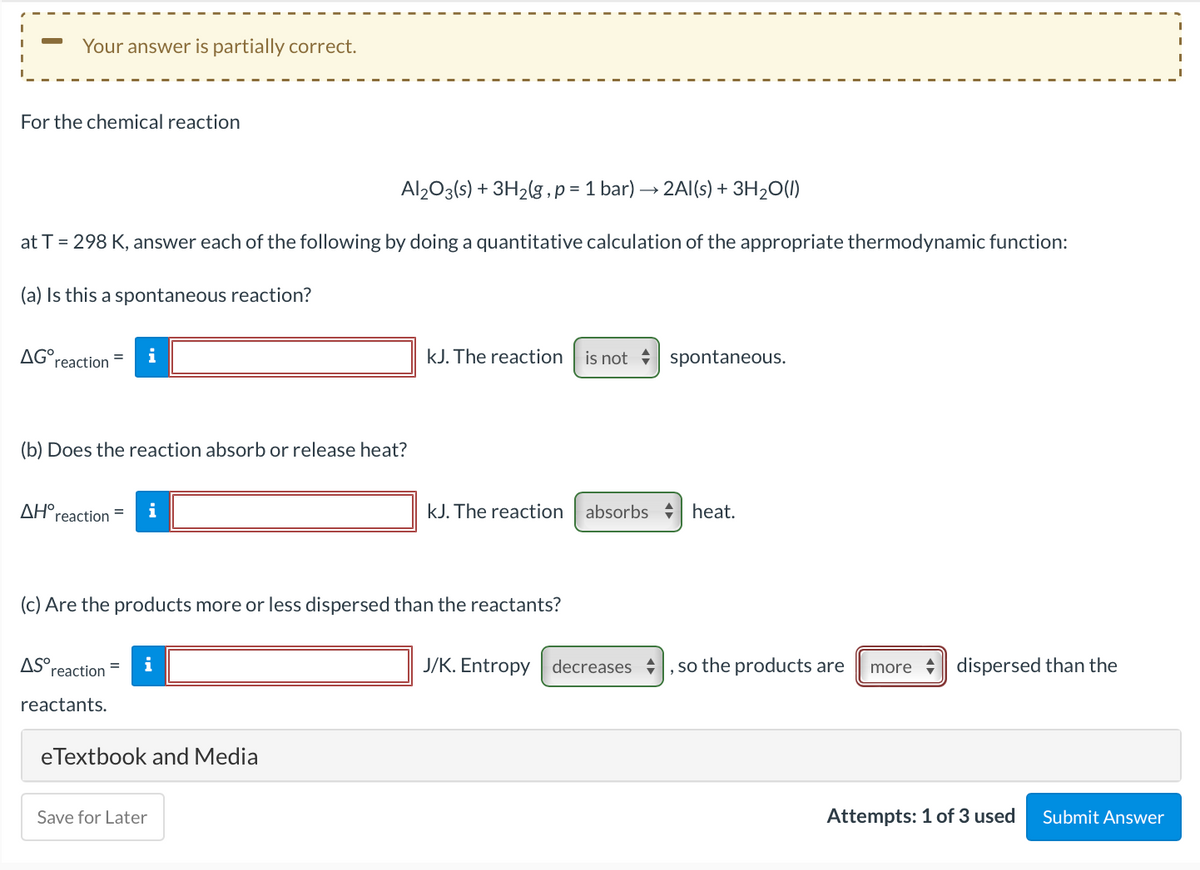Al203(s) + 3H2(g , p = 1 bar) → 2AI(s) + 3H2O(I) at T = 298 K, answer each of the following by doing a quantitative calculation of the appropriate thermodynamic function: (a) Is this a spontaneous reaction? i AG°reaction kJ. The reaction is not spontaneous. %3D (b) Does the reaction absorb or release heat? ΔΗreaction kJ. The reaction absorbs heat. (c) Are the products more or less dispersed than the reactants? AS°reaction J/K. Entropy decreases , so the products are more dispersed than the reactants. eTextbook and Media
Al203(s) + 3H2(g , p = 1 bar) → 2AI(s) + 3H2O(I) at T = 298 K, answer each of the following by doing a quantitative calculation of the appropriate thermodynamic function: (a) Is this a spontaneous reaction? i AG°reaction kJ. The reaction is not spontaneous. %3D (b) Does the reaction absorb or release heat? ΔΗreaction kJ. The reaction absorbs heat. (c) Are the products more or less dispersed than the reactants? AS°reaction J/K. Entropy decreases , so the products are more dispersed than the reactants. eTextbook and Media
Chemistry: An Atoms First Approach
2nd Edition
ISBN:9781305079243
Author:Steven S. Zumdahl, Susan A. Zumdahl
Publisher:Steven S. Zumdahl, Susan A. Zumdahl
Chapter16: Spontaneity, Entropy, And Free Energy
Section: Chapter Questions
Problem 1ALQ: For the process A(l) A(g), which direction is favored by changes in energy probability? Positional...
Related questions
Question
100%

Transcribed Image Text:Your answer is partially correct.
For the chemical reaction
Al203(s) + 3H2(g,p = 1 bar)
2AI(s) + 3H20(1)
at T = 298 K, answer each of the following by doing a quantitative calculation of the appropriate thermodynamic function:
(a) Is this a spontaneous reaction?
AG°reaction
i
kJ. The reaction
is not spontaneous.
(b) Does the reaction absorb or release heat?
ΔΗreaction -
i
kJ. The reaction
absorbs +
heat.
(c) Are the products more or less dispersed than the reactants?
AS°
reaction
i
J/K. Entropy
decreases ÷
so the products are
more + dispersed than the
reactants.
eTextbook and Media
Save for Later
Attempts: 1 of 3 used
Submit Answer
Expert Solution
This question has been solved!
Explore an expertly crafted, step-by-step solution for a thorough understanding of key concepts.
This is a popular solution!
Trending now
This is a popular solution!
Step by step
Solved in 2 steps with 2 images

Knowledge Booster
Learn more about
Need a deep-dive on the concept behind this application? Look no further. Learn more about this topic, chemistry and related others by exploring similar questions and additional content below.Recommended textbooks for you

Chemistry: An Atoms First Approach
Chemistry
ISBN:
9781305079243
Author:
Steven S. Zumdahl, Susan A. Zumdahl
Publisher:
Cengage Learning


Chemistry
Chemistry
ISBN:
9781305957404
Author:
Steven S. Zumdahl, Susan A. Zumdahl, Donald J. DeCoste
Publisher:
Cengage Learning

Chemistry: An Atoms First Approach
Chemistry
ISBN:
9781305079243
Author:
Steven S. Zumdahl, Susan A. Zumdahl
Publisher:
Cengage Learning


Chemistry
Chemistry
ISBN:
9781305957404
Author:
Steven S. Zumdahl, Susan A. Zumdahl, Donald J. DeCoste
Publisher:
Cengage Learning

Principles of Modern Chemistry
Chemistry
ISBN:
9781305079113
Author:
David W. Oxtoby, H. Pat Gillis, Laurie J. Butler
Publisher:
Cengage Learning

Chemistry: The Molecular Science
Chemistry
ISBN:
9781285199047
Author:
John W. Moore, Conrad L. Stanitski
Publisher:
Cengage Learning

Chemistry for Engineering Students
Chemistry
ISBN:
9781337398909
Author:
Lawrence S. Brown, Tom Holme
Publisher:
Cengage Learning